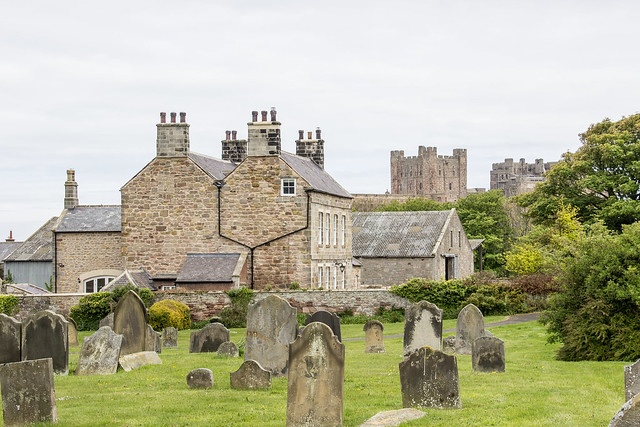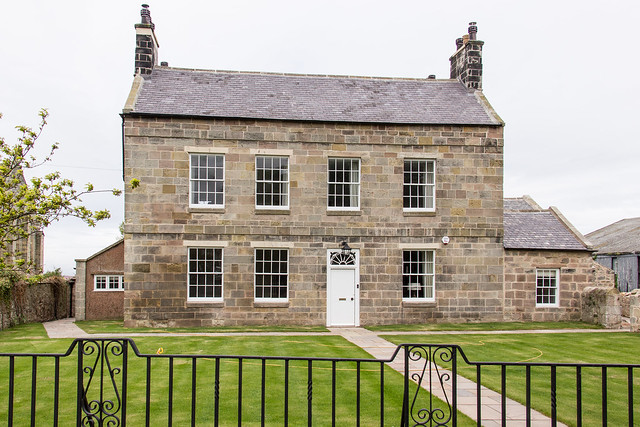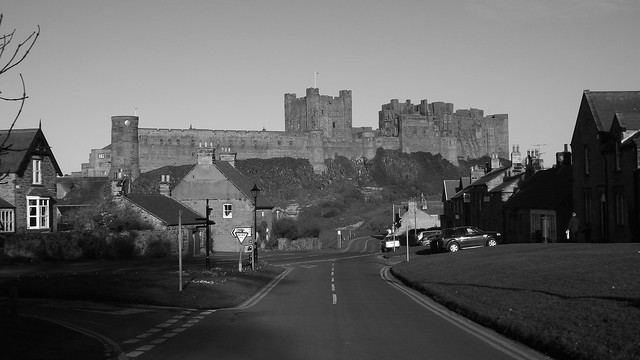St Aidan's Church, Bamburgh, Northumberland, England

-
Description
"St Aidan’s Church, Bamburgh is a Grade I listed Church of England building in the Diocese of Newcastle. According to Bede, St Aidan built a wooden church outside the castle wall, on the site of the current church, in AD 635, and he died here in AD 652; (a wooden beam preserved inside the church is traditionally said to be the one on which he rested as he died). The present church dates from the late 12th century (though some pre-conquest stonework survives in the north aisle). The chancel, said to be the second longest in the country (60 ft), was added in 1230; it contains an 1895 reredos in Caen stone by W.S. Hicks, depicting northern saints of the 7th and 8th centuries. The older, eastern section of the church, has Saxon-style timber roof structure. Note that after the Dissolution of the Monasteries in the mid 1500s, the monks were forced to leave. After the Reformation, St Aidan's became the parish church for the village but its maintenance was neglected; by 1600, it was in poor condition. Repairs were eventually completed. Over the subsequent centuries additional repairs were undertaken, including significant restorations during the 1800s, the last one in 1895. The church's crypt holds the remains of 110 individuals who died in the 7th and 8th century; they had originally been buried in the castle's Bowl Hole graveyard. The remains were found during a project between 1998 to 2007. Finally, in 2016, they were moved into the crypt. Since November 2019, the crypt can be viewed by visitors through a small gate. An interpretive display and digital ossuary are also available for visitors as "Accessing Aidan"; they are managed by the Bamburgh Bones consortium: the Bamburgh Heritage Trust, St. Aidan’s Parochial Church Council, Northumberland Coast AONB Partnership and Northumberland County Council. Bamburgh (/ˈbæmbərə/ BAM-bər-ə) is a village and civil parish on the coast of Northumberland, England. It had a population of 454 in 2001, decreasing to 414 at the 2011 census. The village is notable for the nearby Bamburgh Castle, a castle which was the seat of the former Kings of Northumbria, and for its association with the Victorian era heroine Grace Darling, who is buried there. The extensive beach by the village was awarded the Blue Flag rural beach award in 2005. The Bamburgh Dunes, a Site of Special Scientific Interest, stand behind the beach. Bamburgh is popular with holidaymakers and is within the Northumberland Coast Area of Outstanding Natural Beauty. The site now occupied by Bamburgh Castle was previously home to a fort of the Celtic Britons known as Din Guarie and may have been the capital of the kingdom of Bernicia, the realm of the Gododdin people, from the realm's foundation in c. 420 until 547, the year of the first written reference to the castle. In that year the citadel was captured by the Anglo-Saxon ruler Ida of Bernicia (Beornice) and became Ida's seat. The settlement was originally known as Bamburgh but became Bebbanburg (named after Saxon Queen Bebba) in 615 AD; later in the 7th century, it was renamed Bamburgh. Aidan of Lindisfarne came to this area from the monastery of Iona in 635 on behalf of King Oswald of Northumbria. The medieval village began to develop near the castle. During the Dissolution of the Monasteries the property of the friars, including the castle, were seized on behalf of Henry VIII. Late medieval British author Thomas Malory identified Bamburgh Castle with Joyous Gard, the mythical castle home of Sir Lancelot in Arthurian legend." - info from Wikipedia. Summer 2019 I did a solo cycling tour across Europe through 12 countries over the course of 3 months. I began my adventure in Edinburgh, Scotland and finished in Florence, Italy cycling 8,816 km. During my trip I took 47,000 photos. Now on https://www.instagram.com/billyd.wilson/" rel="noreferrer nofollow">Instagram. Become a patron to my photography on https://www.patreon.com/billywilson" rel="noreferrer nofollow">Patreon. -
Owner
Billy Wilson Photography -
Source
Flickr (Flickr) -
License
What does this mean? Attribution-NonCommercial License
-
Further information
Link: https://www.flickr.com/photos/32132568@N06/49996120757/
Resource type: Image
Added by: Simon Cotterill
Last modified: 9 months, 2 weeks ago
Viewed: 202 times
Picture Taken: 2019-05-18T08:09:23 -
Co-Curate tags










